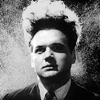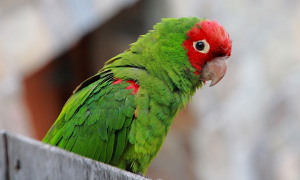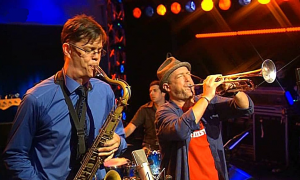Home » Jazz Articles » Genius Guide to Jazz » Duking It Out
Duking It Out
Over time, a unique symbiosis developed between the two. They even developed a popular cabaret act where one would compose a tune while the other drank a glass of water.
 Now, we've already devoted two months to deciding that perhaps Armstrong was worthy of much of the praise he received from Jazz (with the exception of the claims of Louis' supernatural ability to sugar-cure hams using only his mind). But when I was going over my thoughts on the whole thing, I found myself doubting Ellington's hallowed place in jazz. Admittedly, I associated most of his work with big band music, which I tend to dismiss as little more than jazzified pop. Then I actually explored some more definitive samples of the Duke's work, and found that The Searchers and True Grit were two of my all-time favorite movies. Once I sobered up, though, I listened to a more representative array of Ellington's work and came away a changed man.
Now, we've already devoted two months to deciding that perhaps Armstrong was worthy of much of the praise he received from Jazz (with the exception of the claims of Louis' supernatural ability to sugar-cure hams using only his mind). But when I was going over my thoughts on the whole thing, I found myself doubting Ellington's hallowed place in jazz. Admittedly, I associated most of his work with big band music, which I tend to dismiss as little more than jazzified pop. Then I actually explored some more definitive samples of the Duke's work, and found that The Searchers and True Grit were two of my all-time favorite movies. Once I sobered up, though, I listened to a more representative array of Ellington's work and came away a changed man.
 Edward Kennedy Ellington was born in Washington, D.C., on April 29, 1899, to a butler (William Butler Yeats? Fat chance) and his wife (whose wife?), Daisy. Though middle class, Ellington was raised as though he were royalty. This may be where he acquired the nickname Duke, though I had already planned on a John Wayne gag later on that I craftily began setting up in the previous paragraph. I guess that's not going to happen now, but we still have the Yeats joke to keep us going through these tough times.
Edward Kennedy Ellington was born in Washington, D.C., on April 29, 1899, to a butler (William Butler Yeats? Fat chance) and his wife (whose wife?), Daisy. Though middle class, Ellington was raised as though he were royalty. This may be where he acquired the nickname Duke, though I had already planned on a John Wayne gag later on that I craftily began setting up in the previous paragraph. I guess that's not going to happen now, but we still have the Yeats joke to keep us going through these tough times.
Ellington began playing piano very early (around 5:30 AM), and you would expect that he was an immediate prodigy. This was not the case, however, and in fact he never so much as touched a piano again for the rest of his life.
That couldn't be right. I'm sorry, I was thinking of John Wayne again. Anyway.
Ellington in fact did receive piano lessons at a young age and didn't quite take to the instrument. For one thing, the piano was not portable. Young Duke always had an eye for the ladies, and wanted something he could carry around with him for impromptu serenades. Wanting to set himself apart from all the other young would-be wandering minstrels, though, Duke sought something other than just the traditional guitar or saxophone. However, when the banjo proved to be less than a chick magnet and the accordion almost got him arrested for violating D.C.'s Lady of Spain ordinances (aimed at eradicating the spread of accordion- and concertina-related crimes against humanity), Duke went back to the piano to give it another shot.
 Very soon, Duke was building a reputation for himself around D.C. as a stride-influenced pianist with a variety of local and regional groups. Teaming up with drummer Sonny Greer, first as a two-man beach volleyball combo and then playing with fellow Washingtonians Arthur Whetsol and Otto Hardwicke, Ellington's renown grew until he finally found himself in New York City. First with Elmer Snowden (also from Washington), then with the inevitable Duke Ellington and His Washingtonians, he soon landed himself a plum long-term engagement at the legendary Cotton Club in Harlem. Via nationwide radio broadcasts, Duke soon garnered a widespread following that allowed him to take his burgeoning ensemble out on the road where they went 7-4-1 (tying Detroit 3-3 in overtime) before returning home to defeat the Rangers 4-2.
Very soon, Duke was building a reputation for himself around D.C. as a stride-influenced pianist with a variety of local and regional groups. Teaming up with drummer Sonny Greer, first as a two-man beach volleyball combo and then playing with fellow Washingtonians Arthur Whetsol and Otto Hardwicke, Ellington's renown grew until he finally found himself in New York City. First with Elmer Snowden (also from Washington), then with the inevitable Duke Ellington and His Washingtonians, he soon landed himself a plum long-term engagement at the legendary Cotton Club in Harlem. Via nationwide radio broadcasts, Duke soon garnered a widespread following that allowed him to take his burgeoning ensemble out on the road where they went 7-4-1 (tying Detroit 3-3 in overtime) before returning home to defeat the Rangers 4-2.
 More and more, Ellington was honing his compositional skills. The company of exceptional musicians, from Bubber Miley to Joe "Tricky Sam" Nanton (and even briefly Sidney Bechet), added new dimensions to his writing. Duke was able to capture the essence of a great player in his work, so that it seemed to have been written personally for that musician. By bringing out the best in his players by composing to their strengths, Ellington's work took on a more vivid dimension than any of his contemporaries. To a certain degree, he legitimized jazz as a compositional form without compromising the individual freedom that brilliant innovators like Armstrong had already brought to the music. His compositional skills also helped him introduce jazz into the accepted realms of popular culture, writing for stage and screen as well as composing a commissioned tune for President Calvin Coolidge to hum softly to himself on long winter evenings.
More and more, Ellington was honing his compositional skills. The company of exceptional musicians, from Bubber Miley to Joe "Tricky Sam" Nanton (and even briefly Sidney Bechet), added new dimensions to his writing. Duke was able to capture the essence of a great player in his work, so that it seemed to have been written personally for that musician. By bringing out the best in his players by composing to their strengths, Ellington's work took on a more vivid dimension than any of his contemporaries. To a certain degree, he legitimized jazz as a compositional form without compromising the individual freedom that brilliant innovators like Armstrong had already brought to the music. His compositional skills also helped him introduce jazz into the accepted realms of popular culture, writing for stage and screen as well as composing a commissioned tune for President Calvin Coolidge to hum softly to himself on long winter evenings.
 Moreso as a composer, Ellington developed his unique style not by studying classical compositional techniques, but by learning as he went. A great example of on-the-job training, Ellington developed by practical application. He was free from the restraints of convention, and never bound himself to the traditional rules of composition (particularly the "two for flinching" rule, enforced with such brutality by other notable composers. How do you think Hector "Boom Boom" Berlioz got his nickname?). Unlike many artists who have defied convention either by will or ignorance, Ellington's work never descended into self-indulgent tripe. He created complex sonic textures and expanded the acceptable voicing of chordal structures, all while blindfolded and simultaneously riding a unicycle and juggling two bowling balls and a chain saw. Sorry, I was momentarily overcome by Ken Burns Hyperbole Syndrome.
Moreso as a composer, Ellington developed his unique style not by studying classical compositional techniques, but by learning as he went. A great example of on-the-job training, Ellington developed by practical application. He was free from the restraints of convention, and never bound himself to the traditional rules of composition (particularly the "two for flinching" rule, enforced with such brutality by other notable composers. How do you think Hector "Boom Boom" Berlioz got his nickname?). Unlike many artists who have defied convention either by will or ignorance, Ellington's work never descended into self-indulgent tripe. He created complex sonic textures and expanded the acceptable voicing of chordal structures, all while blindfolded and simultaneously riding a unicycle and juggling two bowling balls and a chain saw. Sorry, I was momentarily overcome by Ken Burns Hyperbole Syndrome.
It was Ellington's considerable success as a composer that allowed him to pursue his true love, competitive professional Mah Jong.
 No, wait. Let's try that sentence again.
No, wait. Let's try that sentence again.
It was Ellington's considerable success as a composer that allowed him to pursue his true love, touring. There we go.
Ellington's love of live performing never waned even to his last days, and it was the income provided by his prolific composing that allowed him to tour even as the days of the big band gave way to the rock-and-roll era. But more importantly, appearances at Carnegie Hall and the Metropolitan Opera House allowed him to further legitimize jazz as an essential American art form, almost completely replacing whittling as the representative expression of American selfhood.
 It was perhaps Ellington's egalitarian approach to his craft that played a significant part in bringing jazz to the mainstream. He made the art more accessible, with no concurrent compromise of quality. In other words, he appealed to popular sensibilities without turning jazz into the useless blathering noise that has become Top 40 radio. I don't mean to sound unnecessarily harsh, but I do bet that Ellington—28 years in his grave—could still kick Justin Timberlake's (whose?) ass any day of the week.
It was perhaps Ellington's egalitarian approach to his craft that played a significant part in bringing jazz to the mainstream. He made the art more accessible, with no concurrent compromise of quality. In other words, he appealed to popular sensibilities without turning jazz into the useless blathering noise that has become Top 40 radio. I don't mean to sound unnecessarily harsh, but I do bet that Ellington—28 years in his grave—could still kick Justin Timberlake's (whose?) ass any day of the week.
Anyway.
 Towards the end of the thirties, Ellington met a man who would become "the other half of (his) heartbeat," Pittsburgh pianist and composer Billy Strayhorn. Joining the band originally as a lyricist and backup pianist, Strayhorn's abilities as a composer soon earned him a partnership with Ellington. Though their individual styles remained distinctive, in combination they both challenged and imitated one another to the point where many of Ellington's extended compositions bore the credit "Ellington-Strayhorn." Over time, a unique symbiosis developed between the two. They even developed a popular cabaret act where one would compose a tune while the other drank a glass of water.
Towards the end of the thirties, Ellington met a man who would become "the other half of (his) heartbeat," Pittsburgh pianist and composer Billy Strayhorn. Joining the band originally as a lyricist and backup pianist, Strayhorn's abilities as a composer soon earned him a partnership with Ellington. Though their individual styles remained distinctive, in combination they both challenged and imitated one another to the point where many of Ellington's extended compositions bore the credit "Ellington-Strayhorn." Over time, a unique symbiosis developed between the two. They even developed a popular cabaret act where one would compose a tune while the other drank a glass of water.
This seems as good a place as any to leave off for this month. I've got an überblonde to woo, and I'm sure you have plenty of holiday-related doings to which to attend. Speaking of which, I'd like to wish you the happiest and most blessed of holidays. I look forward to bringing you this compendium of needlessly complex tomfoolery throughout the New Year, and thank you for having been with me this far. Merry Christmas, and a Happy New Year.
Till next month, exit to your right and enjoy the rest of AAJ.
< Previous
In Memory of Keter Betts
Next >
Free to A Good Home
Comments
Tags
For the Love of Jazz
 All About Jazz has been a pillar of jazz since 1995, championing it as an art form and, more importantly, supporting the musicians who create it. Our enduring commitment has made "AAJ" one of the most culturally important websites of its kind, read by hundreds of thousands of fans, musicians and industry figures every month.
All About Jazz has been a pillar of jazz since 1995, championing it as an art form and, more importantly, supporting the musicians who create it. Our enduring commitment has made "AAJ" one of the most culturally important websites of its kind, read by hundreds of thousands of fans, musicians and industry figures every month.























